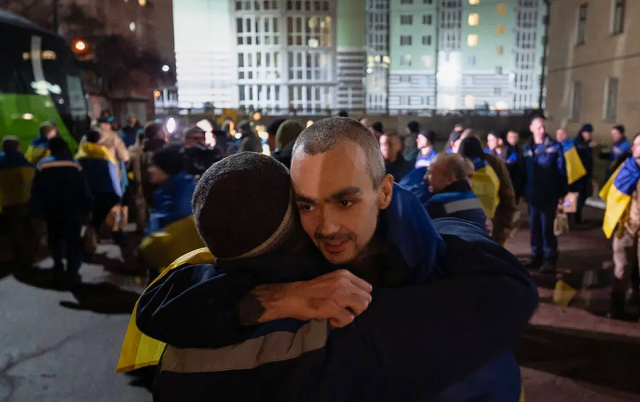
In a significant development, Russia and Ukraine have conducted a substantial prisoner exchange, each side releasing numerous captives in a deal facilitated by the United Arab Emirates (UAE). This marks the 59th such exchange since the onset of the full-scale conflict in February 2022.
Ukrainian President Volodymyr Zelenskyy announced the return of 189 Ukrainian nationals, comprising military personnel from various branches—including soldiers, border guards, National Guardsmen, and Navy servicemen—as well as two civilians captured during the siege of Mariupol. Many of these individuals had endured over two and a half years in captivity, with some suffering from serious illnesses and injuries. Zelenskyy emphasized the nation’s commitment to securing the release of all citizens held by Russia, stating, “We are working to free everyone from Russian captivity. This is our goal. We do not forget anyone.”
Among those freed were defenders of key strategic locations, including the Azovstal steel plant in Mariupol, the Chernobyl nuclear power plant, and Snake Island. Denys Prokopenko, commander of Ukraine’s 12th Special Forces Azov Brigade, noted that 11 of his men were among the returnees. Prokopenko himself had been released in a previous exchange in 2022.
On the Russian side, the Ministry of Defense reported the repatriation of 150 servicemen. These individuals were initially transported to Belarus, where they received medical assistance and the opportunity to contact their families, before being transferred to Russia.
The UAE’s involvement in mediating this exchange underscores its growing role in international diplomatic efforts related to the conflict. Both Ukrainian and Russian authorities have expressed gratitude for the UAE’s facilitation of the swap.
Despite this positive development, thousands of Ukrainians remain in captivity in Russia and occupied territories. Negotiations for prisoner exchanges have reportedly become more challenging in recent months, coinciding with significant Russian advances on the battlefield. Ukrainian officials estimate that over 8,000 of their nationals are currently held by Russia, highlighting the ongoing humanitarian concerns amid the protracted conflict.
Do Both Sides Want Peace?
Public opinion in both Ukraine and Russia regarding the pursuit of peace has evolved notably since the onset of the conflict in February 2022. Recent surveys indicate a growing inclination toward negotiations in both nations, though significant portions of the populations remain steadfast in their initial positions.
In the early stages of the conflict, a substantial majority of Ukrainians favored continued resistance. A Gallup poll conducted shortly after the invasion revealed that 73% preferred to fight until victory was achieved.
However, as the conflict has persisted, public sentiment has shifted. By November 2024, Gallup reported that 52% of Ukrainians favored a negotiated peace, even if it involved making territorial concessions, while 38% still supported continuing the fight until a decisive victory.
This change reflects the prolonged nature of the conflict and the associated hardships, leading to a reevaluation of priorities among the Ukrainian populace.
In Russia, public opinion has also shown a trend toward favoring peace negotiations. A survey by the Levada Center in July 2024 found that 58% of Russians supported initiating peace talks with Ukraine, marking an all-time high.
Despite this inclination toward negotiations, support for the government’s military actions remains substantial. A study by the Chicago Council on Global Affairs indicated that three in four Russians continue to back the military intervention, with 46% expressing strong support.
This dichotomy suggests that while a significant portion of the Russian population desires peace talks, they simultaneously endorse the government’s current military strategies.
The evolving public opinions in both Ukraine and Russia highlight the complexities of the conflict and the diverse perspectives within each nation. In Ukraine, the shift toward favoring negotiations underscores the toll of prolonged warfare on civilian life and national infrastructure. Conversely, in Russia, the simultaneous support for peace talks and military actions reflects a nuanced public stance, possibly influenced by state narratives and media portrayals.



 Subscribe
Subscribe